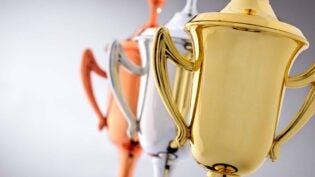Use Psychology to Design a Great Logo
By: SmallBizClub

Designing a great logo is key if you want to give the best impression of your business. Not only will you give a clearer portrayal of your business with a great logo, you’ll also make your business far more memorable and recognizable.
However, there’s more to it than just sketching a few random ideas and making note of what you like. There’s psychology behind every great logo. Whether you’re choosing the color or the shape, you should always consider psychology before making your mind up.
The Psychology of Shapes
Whether consumers are looking at curved lines or edgy shapes, they’re going to take away different feelings. For instance, the Nike ‘swoosh’ is curved and ends in sharp points. This gives the feeling of movement. Here are some things to think about when selecting your logo shape:
- Choosing shapes is also important when choosing your typeface. For example, an angular typeface could hint at aggression. Bold lettering tends to appeal to men more, while curved lettering appeals more to women. Do your research carefully and think about whom your typeface might be appealing to before you decide. Pick your font carefully and try to ensure it matches the persona you want to portray to your visitors. For example, Old Fashioned Bathrooms used an old fashioned font to portray their brand message.
- Vertical lines signify masculinity and strength, while horizontal create feelings of peace and tranquility.
- Triangles can be perceived as more masculine, as well as being associated with science, religion, and law.
- Squares and triangles can imply balance. When using straight lines with them, this gives a feeling of stability.
- Circles, ovals, and similar shapes can help to send a positive emotional message and can convey trust; for example, check out the Air Cargo Eye logo. They are independent journalists in the air cargo field so trust is an important factor.
- Curves in your logo can signify things like happiness and positivity, but there can be downsides to certain shapes, too. For example, an inverted curve can look a bit like a frown.
The shapes you use will help you to convey your message and make consumers feel a certain way, so choose yours carefully. One example of mixing up styles is the Cooksmill logo; it has clean bold fonts, a circular icon and a clean green color.
A company called Image Installation and Maintenance put some real thought behind their logo. It takes advantage of using both curves and sharp corners to portray trust and authority. This provides various visual signals. Mixing shapes can mean a whole host of other things, so make sure you don’t do this at random! Think carefully before making any decisions.
The Psychology of Colors
84% of consumers mention the color when stating their reasons for buying a particular product. This just goes to show how important it is to make the right decision. Here’s a quick rundown of what colors can do for your logo and brand as a whole:
- Blue can give the feeling of calm, trustworthiness, and security.
- Red can imply passion, boldness, love, and energy.
- Orange creates feelings of happiness, affordability, and friendliness.
- Yellow implies confidence, forward thinking, and playfulness.
- Purple is imaginative, creative, and nostalgic.
- Green implies freshness, organic/natural companies, and provokes feelings of caring too.
- Multicolored logos give the feeling of boundlessness, boldness, and positivity.
Bear in mind there can also be downsides to using certain colors. For example, red can sometimes hint at feelings of anger.
How do you want your business to be perceived by consumers? Make sure you choose your shapes and colors carefully to give the best impression of your business. Remember that this can have an impact both online and offline so think carefully about your choices. Rebranding later on down the line is always a difficult task.
 Author: Matt Janaway is a digital & online entrepreneur and marketer, specializing in the retail & eCommerce arena. He has built, purchased, optimized and sold in excess of 10 eCommerce businesses with multi-million pound revenues and is now heading a team project optimizing 30 websites with over 20,000 products. He considers his methods to be scientific and incredibly advanced. Follow him on Google+, Twitter, and LinkedIn.
Author: Matt Janaway is a digital & online entrepreneur and marketer, specializing in the retail & eCommerce arena. He has built, purchased, optimized and sold in excess of 10 eCommerce businesses with multi-million pound revenues and is now heading a team project optimizing 30 websites with over 20,000 products. He considers his methods to be scientific and incredibly advanced. Follow him on Google+, Twitter, and LinkedIn.
2706 Views














